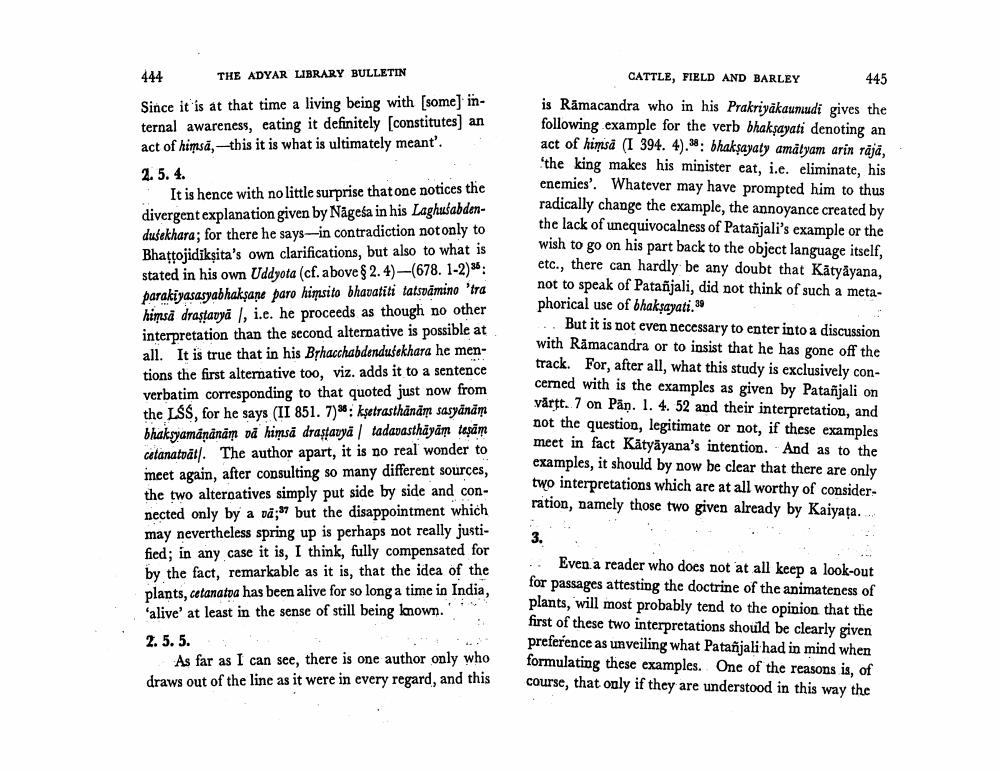Book Title: Cattle Field And Barley Note On Mahabhasya Author(s): A Wezler Publisher: A Wezler View full book textPage 8
________________ 444 THE ADYAR LIBRARY BULLETIN Since it is at that time a living being with [some) internal awareness, eating it definitely [constitutes] an act of himsa,--this it is what is ultimately meant'. 2.5. 4. It is hence with no little surprise that one notices the divergent explanation given by Nageša in his Laghusabdendusekhara; for there he says-in contradiction not only to Bhattojidikşita's own clarifications, but also to what is stated in his own Uddyota (cf. above $2.4)-(678. 1-2)36. parakiyasasyabhakşane paro himsito bhavatiti tatsvamino 'tra himsa drastavyā I, i.e. he proceeds as though no other interpretation than the second alternative is possible at all. It is true that in his Brhacchabdendusekhara he mentions the first alternative too, viz. adds it to a sentence verbatim corresponding to that quoted just now from the LSS, for he says (II 851. 7) kşetrasthänām sasyänām bhak syamananām himsă drastavya/ tadavasthāyām taşām cetanatvät/. The author apart, it is no real wonder to meet again, after consulting so many different sources, the two alternatives simply put side by side and connected only by a da; but the disappointment which may nevertheless spring up is perhaps not really justified; in any case it is, I think, fully compensated for by the fact, remarkable as it is, that the idea of the plants, cetanatva has been alive for so long a time in India, 'alive' at least in the sense of still being Imown.' 2. 5. 5. As far as I can see, there is one author only who draws out of the line as it were in every regard, and this CATTLE, FIELD AND BARLEY 445 is Ramacandra who in his Prakriyakaumudi gives the following example for the verb bhakşayati denoting an act of himsa (I 394. 4).38: bhakşayaty amatyam arin rājā, the king makes his minister eat, i.e. eliminate, his enemies'. Whatever may have prompted him to thus radically change the example, the annoyance created by the lack of unequivocalness of Patañjali's example or the wish to go on his part back to the object language itself, etc., there can hardly be any doubt that Katyayana, not to speak of Patañjali, did not think of such a metaphorical use of bhaksayati.39 ...But it is not even necessary to enter into a discussion with Rämacandra or to insist that he has gone off the track. For, after all, what this study is exclusively concerned with is the examples as given by Patañjali on vårtt. 7 on Pän. 1. 4. 52 and their interpretation, and not the question, legitimate or not, if these examples meet in fact Kätyäyana's intention. And as to the examples, it should by now be clear that there are only two interpretations which are at all worthy of considerration, namely those two given already by Kaiyata... 3. .. Even a reader who does not at all keep a look-out for passages attesting the doctrine of the animateness of plants, will most probably tend to the opinion that the first of these two interpretations should be clearly given preference as unveiling what Patañjali had in mind when formulating these examples. One of the reasons is, of course, that only if they are understood in this way thePage Navigation
1 ... 6 7 8 9 10 11 12 13 14 15 16 17 18 19 20 21 22 23 24
